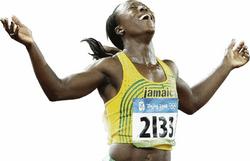
Jamaica's Veronica Campbell-Brown celebrates winning the gold in the women's 200-metre final during the athletics competitions in the national stadium at the Beijing 2008 Olympics in Beijing, Thursday, August 21. - AP
Of course, ground provision intake and appropriate nutrition would not tell the full story of Jamaica's athletic prowess. There are other factors at play related to passion, discipline, hardwork, talent and the blessings of nature.
On November 15, 2006, long before it was fashionable to ask why Jamaica's athletes are so outstanding, I had written and published an article on the topic based on research by Professor Errol Morrison and Patrick Cooper, a Jamaican journalist and businessman. An excerpt is published below as another contribution to the national debate:
Physical characteristics peculiar to black people as a result of their evolution and interface in a tropical environment, the sickle-cell trait and malaria were some of the factors Morrison and Cooper found, almost acting in consort, to produce a disproportionate number of successful black athletes over the decades. Their viewpoint, presented in an essay published in the recent issue of the West Indian Medical Journal 2006; 55(3): 205, places a positive twist on the sickle-cell trait, a condition which people of African origin seem more predisposed to develop, and malaria, an infectious disease transmitted by the Anopheles mosquito, primarily in tropical and sub-tropical regions.
Sickle-shaped cells
The development of sickle-shaped blood cells (relative to sickle-cell trait and disease) is apparently the body's way of protecting itself against the parasites linked to the development of malaria. Sickle-shaped blood cells are not as 'welcoming' as normally-shaped red blood cells to the malaria germs. You may now be wondering, 'so what's the link between sickled cells and athletic prowess?' The link lies somewhere in the use of oxygen.
One would imagine that sickle-shaped cells would compromise the amount of oxygen available to black athletes wanting to perform at the top levels of their profession. However, Morrison and Cooper, quoting from elaborate studies conducted on Olympic athletes from the 1968 Games in Mexico City, find that there are 'compensatory mechanisms' developed by the body to take care of these deficiencies in oxygen intake and use.
Some of these 'compensatory mechanisms' relate to differences in the composition and activity of muscle fibres found in black people when compared to other racial groups. Black people have a higher percentage of fast-twitch fibres and lower levels of slow-twitch fibres than white people. This composition of black muscles is linked to a more rapid conversion of glucose into energy than in white muscles.
One of the studies conducted by Claude Bouchard, geneticist and exercise physiologist, and Jean-Aime Simoneau, exercise biochemist (published 1990), concludes that "the racial differences observed between Africans and Caucasians in fibre-type proportion and enzyme activities ... may well result from inherited variation. These data suggest that sedentary black male individuals are, in terms of muscle characteristics, well endowed for sports events of short duration."
Longer arms and legs
Other studies point to differences in the lung activities that impact athletic prowess in black people. Lung volume among white subjects, for example, was 10 to 15 per cent greater than in their black counterparts, but differences in breathing patterns during exercise and the fact that black subjects consumed more oxygen at every phase of exercising made for more powerful performances.
Morrison and Cooper also point to differences in body type and body proportions that impacted athletic performance. People of African descent have less fat under their skin, narrower hips, longer arms and legs and shorter trunks than other racial groups. These biomechanical advantages, they say, "influence power-to-weight ratio and stride length".
eulalee.thompson@gleanerjm.com

